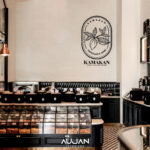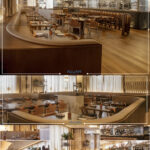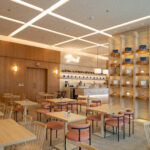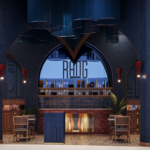Introduction:
In the dynamic landscape of retail, the design and layout of physical spaces play a pivotal role in attracting customers, fostering engagement, and driving sales. With competition intensifying, retailers are continually seeking innovative fitout ideas to differentiate themselves and create memorable experiences for shoppers. This article presents 11 creative ideas for retail spaces, each designed to captivate audiences and leave a lasting impression.
Optimizing Store Layouts:
Retailers understand the importance of optimizing store layouts to enhance customer flow and maximize space utilization. From strategic aisle positioning to innovative shelving solutions, a well-designed layout can significantly impact the overall shopping experience.
Creating Inviting Entrances:
The entrance sets the stage for the shopping journey, serving as the first point of contact between the customer and the brand. By incorporating elements of intrigue, such as captivating displays or interactive features, retailers can entice passersby and draw them into the store.
Harnessing the Power of Visual Merchandising:
Visual merchandising is a potent tool for capturing attention and driving sales. By curating visually stunning displays that highlight products and tell a compelling story, retailers can spark interest and inspire purchase decisions.
Innovative Product Presentation:
Beyond aesthetics, innovative product presentation can elevate the shopping experience and create moments of delight for customers. From experiential showcases to interactive demonstrations, retailers can engage multiple senses and forge emotional connections with their audience.
Personalization:
In today’s retail landscape, personalization is key to building meaningful relationships with customers. By leveraging data analytics and technology, retailers can customize experiences based on individual preferences, creating a sense of exclusivity and relevance.
Seamless Integration of Online and Offline Channels:
The seamless integration of online and offline channels is essential for meeting the evolving needs of modern consumers. By offering a cohesive omnichannel experience, retailers can provide convenience, flexibility, and continuity across various touchpoints.
Sustainable Design Practices:
As sustainability becomes a growing concern for consumers, retailers are embracing eco-friendly design practices to reduce their environmental footprint and resonate with socially conscious shoppers. From energy-efficient lighting to recycled materials, sustainable fitouts demonstrate a commitment to environmental stewardship.
Immersive Experiential Spaces:
Immersive experiential spaces blur the lines between retail and entertainment, offering customers memorable experiences that transcend traditional shopping. Whether through interactive installations or immersive storytelling, retailers can create destinations that inspire exploration and foster community.
Dynamic Flexibility:
In a rapidly evolving retail landscape, flexibility is essential for staying agile and responsive to changing consumer trends and preferences. Modular fixtures, versatile layouts, and adaptable spaces empower retailers to transform their stores quickly and efficiently, ensuring relevance and resilience in the face of uncertainty.
Cultivating Brand Loyalty:
Beyond transactions, successful retailers focus on cultivating brand loyalty by building emotional connections with their customers. By delivering exceptional service, personalized interactions, and memorable experiences, retailers can foster loyalty and advocacy, turning customers into brand ambassadors.
Community Engagement Initiatives
Community engagement initiatives provide retailers with opportunities to connect with their local communities, build goodwill, and drive positive social impact. Whether through charitable partnerships, educational events, or cultural celebrations, retailers can strengthen their ties with customers and foster a sense of belonging.
Now, let’s delve into 11 innovative fitout ideas that can transform retail spaces and elevate the shopping experience:
Biophilic Design: Bringing Nature Indoors
Incorporating elements of biophilic design, such as greenery, natural materials, and ample natural light, can create a welcoming and rejuvenating atmosphere for customers.
Interactive Digital Signage: Engaging and Informative Displays
Utilizing interactive digital signage allows retailers to deliver dynamic content, promotions, and product information in a captivating and interactive format.
Modular Pop-Up Spaces: Versatile and Evolving Environments
Embracing modular pop-up spaces enables retailers to experiment with new concepts, engage customers with limited-time experiences, and keep the store environment fresh and dynamic.
Smart Fitting Rooms: Enhancing the Try-On Experience
Implementing smart fitting rooms equipped with augmented reality mirrors and personalized recommendations can streamline the try-on process and enhance the overall shopping experience.
Artisanal Workshops: Celebrating Craftsmanship and Creativity
Hosting artisanal workshops and demonstrations allows retailers to showcase craftsmanship, engage customers in hands-on experiences, and create a sense of authenticity and connection.
Multisensory Experiences: Stimulating the Senses
Designing retail environments that appeal to multiple senses, such as sight, sound, smell, and touch, can create immersive and memorable experiences that resonate with customers on a deeper level.
In-Store Cafés and Lounges: Creating Social Hubs
Integrating in-store cafés and lounges provides customers with a space to relax, socialize, and extend their stay, fostering a sense of community and encouraging repeat visits.
Flexible Retail Spaces: Adaptable and Agile Environments
Designing flexible retail spaces that can be easily reconfigured and repurposed allows retailers to accommodate changing product assortments, seasonal trends, and special events with ease.
Art Installations: Inspiring Creativity and Conversation
Incorporating art installations into retail spaces adds visual interest, sparks curiosity, and encourages dialogue, creating memorable moments for customers to share and remember.
Interactive Product Demonstrations: Hands-On Learning Experiences
Offering interactive product demonstrations and tutorials empowers customers to engage with products firsthand, gain deeper insights, and make more informed purchase decisions.
Digital Integration: Seamless Online and Offline Connectivity
Leveraging digital technologies, such as mobile apps, QR codes, and virtual reality experiences, bridges the gap between online and offline retail, providing customers with seamless connectivity and access to additional resources.
Frequently Asked Questions (FAQs):
Q: What are some cost-effective fitout ideas for small retail spaces?
A: Embracing minimalistic design principles, utilizing versatile fixtures, and maximizing vertical space can help optimize small retail spaces without breaking the budget.
Q: How can retailers create memorable experiences for customers within a limited budget?
A: By focusing on creativity, authenticity, and personalization, retailers can craft memorable experiences that leave a lasting impression, regardless of budget constraints.
Q: What role does lighting play in retail fitout design?
A: Lighting not only enhances visibility and ambiance but also influences mood, perception, and purchasing behavior, making it a critical aspect of retail fitout design.
Q: How can retailers stay updated on the latest trends in retail fitout design? A: Retailers can stay updated on the latest trends in retail fitout design by attending industry conferences, networking with other professionals, following design publications, and seeking inspiration from innovative brands and concepts.
Q: Why is it important for retailers to consider sustainability in fitout design?
A: Incorporating sustainable practices in fitout design not only demonstrates corporate responsibility but also appeals to environmentally conscious consumers, enhances brand reputation, and reduces long-term operational costs.
Q: How can retailers measure the success of their fitout design efforts?
A: Retailers can measure the success of their fitout design efforts through various metrics, including foot traffic, sales conversion rates, customer feedback, and brand perception surveys.
Conclusion
The evolution of retail fitout design is driven by innovation, creativity, and a deep understanding of consumer behavior. By embracing these 11 creative ideas for retail spaces can create immersive, memorable experiences that resonate with customers and drive business growth. From biophilic design elements to interactive digital experiences, the possibilities for enhancing retail spaces are limitless. By prioritizing sustainability, flexibility, and community engagement, retailers can future-proof their stores and cultivate lasting connections with their audience.






